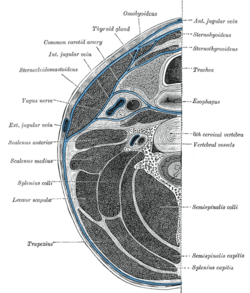| Prevertebral space | |
|---|---|
 Section of the neck at about the level of the sixth cervical vertebra. Showing the arrangement of the fascia coli. | |
 Sagittal section of nose mouth, pharynx, and larynx. | |
| Anatomical terminology |
The prevertebral space is a space in the neck.
On one side it is bounded by the prevertebral fascia.[1]
On the other side, some sources define it as bounded by the vertebral bodies,[2] and others define it as bounded by the longus colli.[1]
It includes the prevertebral muscles (longus colli and longus capitis), vertebral artery, vertebral vein, scalene muscles, phrenic nerve and part of the brachial plexus.[3]
In trauma, an increased thickness of the prevertebral space is a sign of injury, and can be measured with medical imaging.[4]
Clinical significance[edit]
On plain radiography, prevertebral space should be less than 6 mm at C3 vertebral level in children; while in adults, the space should be less than 6 mm at C2 level and less than 22 mm at C6 level. Causes of enlarged prevertebral space could be edema, hematoma, abscess, tumors, and post surgical changes.[5]
References[edit]
- ^ a b "eMedicine - Retropharyngeal Abscess : Article by Todd J Berger, MD". Retrieved 2008-02-18.
- ^ "Deep Neck Space Infections: Changing Trends". Archived from the original on March 19, 2007. Retrieved 2008-02-18.
- ^ "Prevertebral space cervical". Medcyclopaedia. GE.[dead link]
- ^ a b Rojas, C.A.; Vermess, D.; Bertozzi, J.C.; Whitlow, J.; Guidi, C.; Martinez, C.R. (2009). "Normal Thickness and Appearance of the Prevertebral Soft Tissues on Multidetector CT". American Journal of Neuroradiology. 30 (1): 136–141. doi:10.3174/ajnr.A1307. ISSN 0195-6108. PMC 7051716.
- ^ Debnam JM, Guha-Thakurta N (December 2012). "Retropharyngeal and prevertebral spaces: anatomic imaging and diagnosis". Otolaryngologic Clinics of North America. 45 (6): 1293–310. doi:10.1016/j.otc.2012.08.004. PMC 3994542. PMID 23153750.
![CT scan with upper limits of the thickness of the prevertebral space at different levels.[4]](https://upload.wikimedia.org/wikipedia/commons/thumb/d/d2/CT_of_prevertebral_space.jpg/151px-CT_of_prevertebral_space.jpg)
Well, that’s interesting to know that Psilotum nudum are known as whisk ferns. Psilotum nudum is the commoner species of the two. While the P. flaccidum is a rare species and is found in the tropical islands. Both the species are usually epiphytic in habit and grow upon tree ferns. These species may also be terrestrial and grow in humus or in the crevices of the rocks.
View the detailed Guide of Psilotum nudum: Detailed Study Of Psilotum Nudum (Whisk Fern), Classification, Anatomy, Reproduction